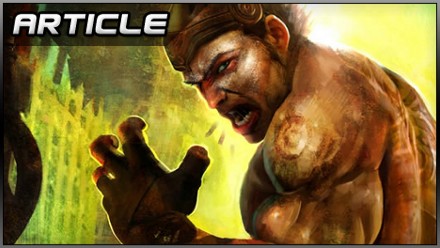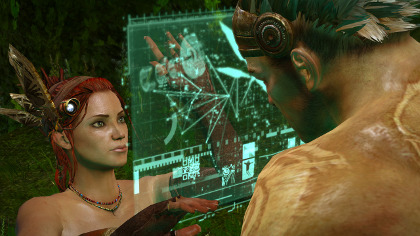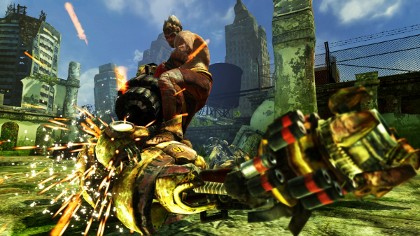
Last night I finally got around to firing up Enslaved: Odyssey to the West, Ninja Theory’s very loose homage to Journey to the West, the sprawling anthropomorphic 16th century novel penned by Wu Cheng’en. Colour me impressed. Actually, colour me a wonderful mingled shade of tropical fern and verdigris. One of the game’s big achievements, as Rupert notes in his preview, is to reintroduce greens, oranges, yellows among other “girlier” hues to shabby post-nuclear spectrums. It’s like looking at an earthquake zone through the bottom of a Sprite bottle, or to pick out a few gaming analogies, like getting Fallout 3 hammered at Jak & Daxter’s private club, then sending it on a blind date with the Oddworld franchise.
As you’d expect from the minds behind King Bohan, the characters are well-rounded, conventional enough to be comfortable but quirky enough to keep you guessing. While he looks quite the bruiser with his sledgehammer jaw and elephant biceps, leading man Monkey’s far more of an action-slapstick fall-guy, Jackie-Chan-style, than an unsmiling Fenix clone. The big-eyed Trip, Monkey’s fellow fugitive turned slave-driver, is a funny mix of cowardice, petulance and artfulness – sexy in a gangly kind of way, very much a damsel in distress, but no mere sun-tanned chunk of eye candy.

Trip's a bit of a tech whiz. One of the first things she does is clamp a mind-control helmet on Monkey's head. Cute.
Characters are “brought to life”, as the cliché goes, by dynamic animation, like the way Monkey straightens up from a scurrying sprint to a measured jog as you hold the left stick. Cut scenes are marvels of direction and optimisation. Lips wrap themselves around Hollywood-level dialogue exactly, performances convince with deft touches like a dropping of the eyes.
If Enslaved’s art design, technical chops and characterisations appeal, I’m left more than a little worried by what I’ve actually played, rather than passively appreciated. Ninja Theory appears to have taken the same road they took with Heavenly Sword, that of the linear cinematic blockbuster founded on an alluring depth of fiction. The game has already been praised, in fact, on precisely this count: Edge’s reviewer notes that it’s “unafraid to make the case for a rollercoaster of a story, well told.”
There’s certainly a place for games that funnel the player from one lavishly arrayed story flashpoint or scenic overview to the next, and indeed many of the industry’s top-scorers, like Uncharted 2: Among Thieves, are cut from this cloth. But it’s a formula that demands a bit of underlying flex if the title in question isn’t to hit a critical glass ceiling. Naughty Dog’s peek-shoot-and-jumper might have kept its point As and Bs firmly in line, but it introduced variance at the micro level in the form of props like riot shields and propane tanks, multiple elevations and asymmetrical or destructable cover layouts. It also had an online component to bust the confines of the storyline wide open. Enslaved certainly lacks the latter, and may also, I fear, lack the former.

Armed with a power shield, multi-purpose combat staff and exceedingly large muscles, Monkey's more than a match for a mech.
The first couple of chapters give this impression, anyway. Ninja Theory has thrown together a truly mind-bending opener, with Monkey hauling arse through and over the surface of a fast-deteriorating slaver airship, but the thunder of prison pods kicking loose from their tethers and the crunch of detaching wings are patently of the smoke-and-mirrors school of spectacle, meant to obfuscate the tedium of repeatedly tapping A to leapfrog shimmering handholds, or massaging X and Y to shatter Enslaved’s mechanical baddies.
The game’s “rollercoaster” credentials make me wonder how much of an asset Andy Serkis, who produced it and mo-capped the star, and Alex Garland, who wrote the script, really were. Serkis and Garland are gifted artists, but they’re artists best-known for their work in film and literature, comparative strangers to the art of videogame development (the former marginally less so, of course, having worked as dramatic director on Heavenly Sword). They’re accustomed to handling, organising the perceptions and responses of those who encounter their work, rather than allowing the user to handle and organise the work in turn.
Enslaved: Odyssey to the West has attracted positive buzz already. There’s little doubt that the story will be worth experiencing, and Ninja Theory’s reimagining of antiquated Chinese conceits is striking. But will the game be volatile and open-minded enough to qualify as a “game” in the sense that ought, one feels, to remain the norm? Or will it be that most tepid of things, a “movie game” or “popcorn muncher”, a squandering of the imagination on a choice-free framework, cinematic safari as opposed to a world to dispose of?
Our Enslaved review drops soon – the game’s out on 5th October in the States and 8th October over ‘ere. Feel free to call the score.





 Satoru Iwata Video Interview - the late Nintendo president spoke with Kikizo in 2004 as 'Nintendo Revolution' loomed.
Satoru Iwata Video Interview - the late Nintendo president spoke with Kikizo in 2004 as 'Nintendo Revolution' loomed. Kaz Hirai Video Interview - the first of Kikizo's interviews with the man who went on to become global head of Sony.
Kaz Hirai Video Interview - the first of Kikizo's interviews with the man who went on to become global head of Sony. Ed Fries Video Interview - one of Xbox's founders discusses an epic journey from Excel to Xbox.
Ed Fries Video Interview - one of Xbox's founders discusses an epic journey from Excel to Xbox. Yu Suzuki, the Kikizo Interview - we spend time with one of gaming's most revered creators.
Yu Suzuki, the Kikizo Interview - we spend time with one of gaming's most revered creators. Tetris - The Making of an Icon: Alexey Pajitnov and Henk Rogers reveal the fascinating story behind Tetris
Tetris - The Making of an Icon: Alexey Pajitnov and Henk Rogers reveal the fascinating story behind Tetris Rare founders, Chris and Tim Stamper - their only interview? Genuinely 'rare' sit down with founders of the legendary studio.
Rare founders, Chris and Tim Stamper - their only interview? Genuinely 'rare' sit down with founders of the legendary studio. The History of First-Person Shooters - a retrospective, from Maze War to Modern Warfare
The History of First-Person Shooters - a retrospective, from Maze War to Modern Warfare